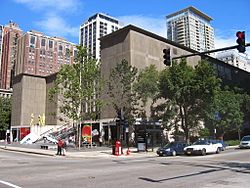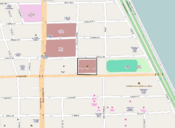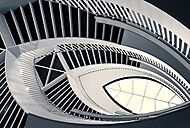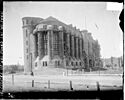Museum of Contemporary Art Chicago facts for kids
The Museum of Contemporary Art (MCA) Chicago is a modern art museum located in downtown Chicago, Illinois. "Contemporary art" means art made in our time, usually from the mid-20th century to today. The museum opened in 1967 and is now one of the largest of its kind in the world.
The MCA's collection includes thousands of artworks created after World War II. Instead of showing the same art all the time, the museum hosts special exhibitions that change throughout the year. These shows might feature art on loan from other places, pieces from the museum's own collection, or a mix of both.
The museum has been the first to show many famous artists in the United States. For example, it hosted the first U.S. exhibition for Frida Kahlo and the first solo museum show for Jeff Koons. An exhibition of work by Takashi Murakami in 2017 set the museum's all-time attendance record. The museum's collection features famous artists like Jasper Johns, Andy Warhol, Cindy Sherman, and Alexander Calder. It includes art styles like surrealism, pop art, minimalism, and conceptual art. The museum also presents dance, theater, and music performances.
The MCA is located at 220 East Chicago Avenue, near Lake Michigan. The building was designed by German architect Josef Paul Kleihues. It is famous for its grand staircase, large glass walls that offer views of the city, and a sunny central area called an atrium.
Contents
History
The Museum of Contemporary Art Chicago was founded in 1964. A group of art collectors and critics wanted to create a museum for modern art to go along with the famous Art Institute of Chicago. The museum first opened in 1967 in a small building on East Ontario Street that used to be a bakery.
At first, the museum was mainly a space for temporary shows, much like a German kunsthalle (art hall). But in 1974, it started its own permanent collection of art made after 1945. As the museum grew, it bought the building next door in 1977 to create more gallery space.
By the 1990s, the museum needed an even bigger home. The board of trustees raised millions of dollars to build a new museum. They looked at designs from architects all over the world and chose Josef Paul Kleihues from Berlin, Germany.
The new building opened in 1996 at its current location on East Chicago Avenue. This spot was once the site of a National Guard Armory, which was torn down to make way for the museum. The new building was five times larger than the old one. It opened with a 24-hour celebration that attracted over 25,000 visitors.
Exhibitions
The MCA is famous for its exciting and groundbreaking exhibitions.
Famous Past Shows
In its early years, the museum showed work by important artists like Dan Flavin, Roy Lichtenstein, and Andy Warhol. In 1969, the artist Christo famously wrapped the entire museum building in over 8,000 square feet of tarp and rope. It was his first building wrap in the United States.
The museum has also introduced major international artists to American audiences. It hosted the first U.S. exhibitions for artists like Frida Kahlo (1978) and the first solo museum show for Jeff Koons (1988).
More recently, the museum has hosted very popular shows that have broken attendance records.
- David Bowie Is (2014): This was the only U.S. stop for a popular exhibition about the life and career of musician David Bowie. It was a huge success and brought in thousands of visitors.
- Takashi Murakami: The Octopus Eats Its Own Leg (2017): This colorful exhibition by the Japanese artist Takashi Murakami became the most-attended show in the museum's history, with over 193,000 visitors.
- Virgil Abloh: "Figures of Speech" (2019): This show looked at the work of designer Virgil Abloh, who was known for his fashion brand Off-White and his work with Louis Vuitton.
- Nick Cave: Forothermore (2022): This was the first career-spanning show for the Chicago artist Nick Cave, known for his amazing "Soundsuits."
Regular Events
The MCA offers many fun programs for the public.
- Tuesdays on the Terrace: Every summer, the museum hosts free outdoor jazz concerts on its terrace.
- Farmers Market: Also on Tuesdays from June to October, a farmers market is held on the museum's plaza.
- Family Days: The museum holds monthly Family Days with fun art activities for all ages.
- Chicago Works: This exhibition series focuses on artists from the Chicago area, giving them a large gallery space to show their work for three months.
Performance Stage
The MCA has a theater called the MCA Stage where it presents live performances. This includes dance, music, theater, and film from artists in Chicago and around the world. Famous performers like dancer Mikhail Baryshnikov and composer Philip Glass have appeared on its stage.
Every year, the museum hosts Chicago Performs, a festival of new and experimental performances by local artists.
The Museum Building
The MCA's building was designed by architect Josef Paul Kleihues and is an artwork in itself. The five-story structure is made of limestone and cast aluminum.
Key Features
- Grand Staircase: A wide, 32-step staircase leads up to the main entrance.
- Glass Walls: The front and back of the building have huge glass walls. These let in natural light and provide amazing views of the city and Lake Michigan.
- Atrium: Inside, a tall, open space called an atrium connects the entrance to the museum's restaurant.
- Galleries: The museum has 45,000 square feet (4,200 m2) of gallery space spread across its floors, including large two-story galleries for major exhibitions.
- Sculpture Garden: Outside, there is a 34,000 square feet (3,200 m2) garden with sculptures by artists like Sol LeWitt and George Rickey.
In 2017, for its 50th anniversary, the museum renovated parts of the building. It added a new restaurant called Marisol, a social space called the Commons, and new classrooms.
Collection
The MCA's permanent collection includes about 2,700 artworks and over 3,000 artist's books. The collection focuses on art from 1945 to today. It features major art movements like pop art, minimalism, and conceptual art, as well as modern painting, sculpture, photography, and video.
Highlights from the Collection
- Retroactive II (1963) by Robert Rauschenberg
- Jackie Frieze (1964) by Andy Warhol
- Rabbit (1986) by Jeff Koons, a famous shiny, stainless-steel bunny.
- Cindy (1988) by Chuck Close
- Presenting Negro Scenes... (1997) by Kara Walker, an installation using black paper cut-outs.
The museum is committed to collecting art from a wide range of artists. It has more works by women and artists of color than many other major museums.
Visiting the Museum
The museum is open Wednesday through Sunday from 10 a.m. to 5 p.m. and has longer hours on Tuesdays, staying open until 9 p.m. It is closed on Mondays.
While there is a suggested admission price, entry is always free for visitors 18 and under, MCA members, and military personnel. Admission is also free for all Illinois residents every Tuesday.
See also
 In Spanish: Museo de Arte Contemporáneo de Chicago para niños
In Spanish: Museo de Arte Contemporáneo de Chicago para niños
- Architecture of Chicago
- List of contemporary art museums
- List of museums and cultural institutions in Chicago
- Visual arts of Chicago







